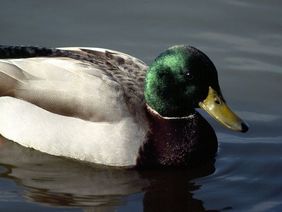Mallard (Anas platyrhynchos)

Description: Large, most commonly seen duck. The males have a gray body, a
chestnut brown breast, white “collar” or narrow ring around the neck, green
iridescent head, and yellow beak with a black tip. The rump and under tail are
black while the tail has white feathers on the outside, black on the inside. Females
are mottled brown and black and have a head and neck that is a lighter brown
than the body. Their yellow beaks are mottled with black. Both males and
females have orange, webbed feet.
Habitat: Found in virtually any wetland environment. However, they prefer shallow marshes and fresh water.
Diet: Omnivorous, eating anything from seeds, acorns, grain, stems, and roots to sedges, grasses, pondweeds, and smartweeds and even aquatic invertebrate, such as insects and larvae. In many locations, humans provide food all year long. Young mallards most frequently eat insect larvae, along with many other aquatic invertebrates.
Behaviors:
Miscellaneous:
Habitat: Found in virtually any wetland environment. However, they prefer shallow marshes and fresh water.
Diet: Omnivorous, eating anything from seeds, acorns, grain, stems, and roots to sedges, grasses, pondweeds, and smartweeds and even aquatic invertebrate, such as insects and larvae. In many locations, humans provide food all year long. Young mallards most frequently eat insect larvae, along with many other aquatic invertebrates.
Behaviors:
- Mallards commonly forage in two ways, by up-ending themselves in shallow water or by grazing on land. Some are also known to “filter-feed” at the surface of a lake or pond.
- To attract females, males grunt, whistle, swim, pump their heads, and preen. The females respond to the males with loud calls or “suggestive body movements.”
- Mallards pair up for mating in the fall and winter, and remain together through the winter into the spring. However, once the females begin incubating the eggs, the pair usually split.
- Mallards scrape a depression into the ground and then line and pad it with vegetation and down feathers from the female’s breast.
Miscellaneous:
- The Mallard is the ancestor of nearly all domestic duck breeds

